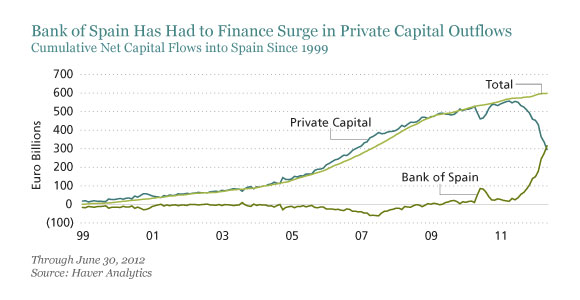Capital flight from Spain is accelerating. As foreign investors and banks pull massive sums out of the country, policymakers look powerless to stop it.
So far this year, there has been a net capital outflow from Spain of €220 billion. We can identify three main channels: foreign investors sold €84 billion of Spanish securities, mostly bank debt and government bonds; foreign banks withdrew €91 billion of loans or deposits from Spain; and banks located in Spain shifted €61 billion of deposits abroad.
The sums are huge, equal to 41% of Spain’s annual gross domestic product (GDP). To cover this outflow and a modest current account deficit of €17 billion, the Bank of Spain was forced to borrow €237 billion from other central banks in the euro area.
Some historical context is helpful. Spain has run a persistent current account deficit since joining the euro in 1999. Until the second half of 2011, this was financed by private capital flows, with some $555 billion (net) entering Spain, as the display below shows. Since then, €316 billion (net) of capital has fled the country. Only the Bank of Spain’s ability to create an inexhaustible supply of foreign reserves by borrowing euros from the rest of the Eurosystem has prevented a balance of payments crisis of enormous proportions.

These flows are changing the nature of Spain’s external liabilities. By the middle of 2011, Spain’s net external liabilities had reached a record €990 billion, which is 93% of GDP. Since then, the overall position has changed little, but risk has shifted from the private sector to the official sector.
At the end of the first quarter, Bank of Spain borrowing from the rest of the Eurosystem accounted for 28% of Spain’s net external liabilities; preliminary indications suggest that since then, its share has risen above 40%. Likewise, our estimates suggest that Bank of Spain borrowing from the rest of the Eurosystem now accounts for 24% of Spain’s €1.7 trillion gross external debt.
In many respects, what is currently playing out in Spain is similar to what happened with Greek government debt: risk is being transferred from private-sector balance sheets to official creditors. In Greece’s case, anxious creditor nations eventually decided to impose losses on bondholders in order to limit their own exposure to the Greek government.
A failure by official entities in the Eurosystem to accommodate these flows would effectively terminate the currency union, so it is hard to see how policymakers can prevent past capital flows into Spain from reversing and spilling over onto their own balance sheets—except by soothing investor concerns that Spain might eventually leave the euro. Perhaps this is one reason that the ECB is now ready to intervene more aggressively in the crisis.
The views expressed herein do not constitute research, investment advice or trade recommendations and do not necessarily represent the views of all AllianceBernstein portfolio-management teams.